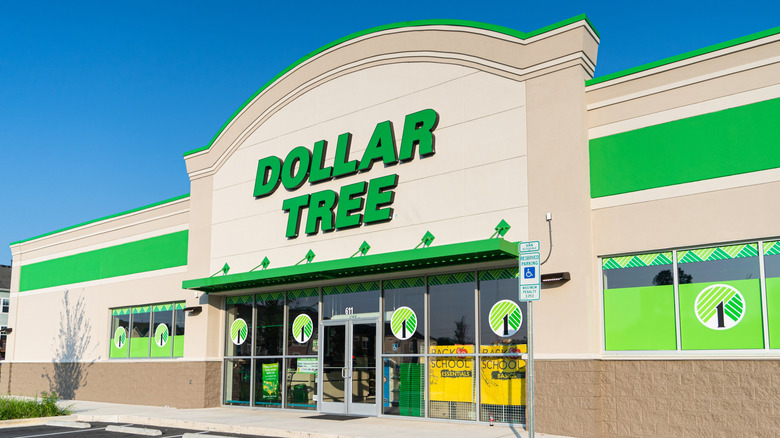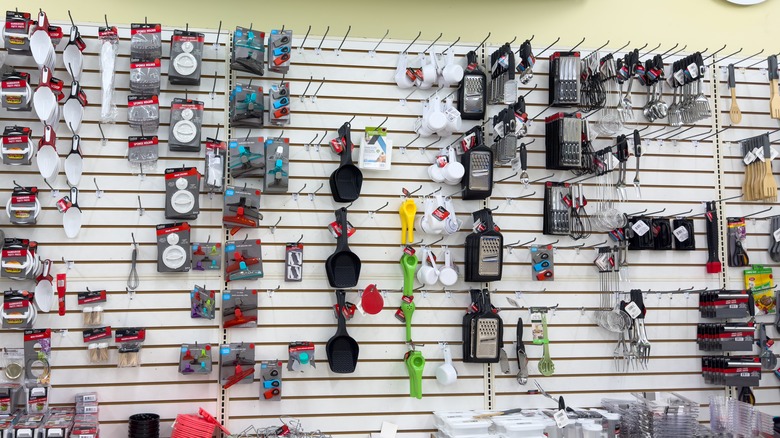Dollar Tree Is Increasing Store Prices And It Isn't The First Time
If you see a red sticker on an item at your local Dollar Tree, it could mean the item's price is about to go up. Per a recent report from Business Insider, a red sticker means that a marked product's price will soon increase from the typical $1.25 to $1.50, if it hasn't already. But while many customers have grumbled about the red stickering trend on social media, Dollar Tree executives have told investors that the price hikes have not yet hurt sales volume. Instead, they're heading up.
"They're walking in and they're seeing value," Dollar Tree CEO Michael Creedon said in a September 2025 earnings call, per a Yahoo! Finance transcript. "We still have 85% of our stores' at $2 or less. Think about that. You walk in and you're finding value around every corner. We think our customer is really pleased with that."
According to Dollar Tree's second quarter earnings report for 2025, sales went up 12.3% year-over-year in the second quarter of 2025. Creedon also asserted during the September earnings call that Dollar Tree added 2.4 million new customers by the end of the second quarter. "Even though we did take some price [increases] in Q2, units were still up," Creedon told investors. While the CEO seems pretty happy with these results, that customer satisfaction might not be as unanimous as his language implies.
Dollar Tree hasn't been a literal dollar store for awhile
This isn't the first time Dollar Tree, a retail chain with 9,000 stores across the U.S. and Canada, increased prices. Dollar Tree raised its base price from $1 to $1.25 in 2021 and, that same year, widely implemented its Dollar Tree Plus section where items are priced between $3 and $5. By 2024, Dollar Tree grew its inventory to include items priced up to $7. Then, after expecting a $70 million hit from tariffs, Dollar Tree announced its plans to enact strategic price hikes in 2025, per Business Insider. That included selectively increasing its base pricing from $1.25 to $1.50, though some items, such as Dollar Tree's foil pans, went up to $1.75.
The reason this popular discount chain is increasing prices is to adapt to tariffs that are inflating the price of essential household items. But Creedon told investors that price hikes were just one of five "levers to mitigate these cost pressures" the company had developed to keep its overhead down. The other four methods are negotiating with suppliers, redesigning products, shifting country of origin (i.e. where Dollar Tree buys its products from), and dropping less cost-effective stock keeping units used to keep track of inventory. Despite all these potential changes, Creedon went on to insist that these efforts would ensure continued customer satisfaction and keep prices from going up further.
With prices rising, who is Dollar Tree's target demographic?
Despite Dollar Tree's relatively low prices, it isn't just low wage earners or those with job insecurity who appreciate Dollar Tree's pricing. Creedon told investors that the majority of its new customers are from households that earn more than $100,000 a year. He credited that uptick in high earners to the fact that Dollar Tree stores stock items that cost more than $2 in its inventory.
"Expanding our assortment to include items at a variety of price points is fast becoming the standard Dollar Tree model," Creedon said, before highlighting how selling such a diverse selection of products at a wider range of price points could appeal to a wider selection of people.
The influx of higher income shoppers toward Dollar Tree is also part of a larger trend. According to GlobalData Retail, via CBS News, 59.2% of people in the $56,501 to $169,750 income bracket shopped at discount retailers in 2025. In contrast, just 47.5% of shoppers from that same income bracket went to places such as Dollar Tree, Five Below, Family Dollar or Walmart back in 2021. As for people who earn $169,751 a year or more, which would include many of those with the highest paying jobs in America, the proportion of discount shoppers also climbed from 19.8% in 2021 to 27.5% in 2025.


